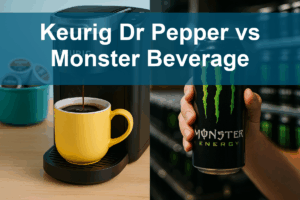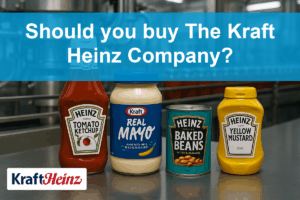The Procter & Gamble Company revolutionizes everyday life, seamlessly integrating its trusted brands into our daily routines. With an extensive portfolio spanning beauty, health care, and household essentials, P&G consistently sets the standard for quality and innovation in the consumer goods sector. From the comforting touch of a Tide laundry detergent to the refreshing experience of a Pantene shampoo, the company’s products are an integral part of millions of households worldwide. As we delve into this investment analysis, one must consider: do P&G’s fundamentals still support its robust market valuation and growth trajectory?
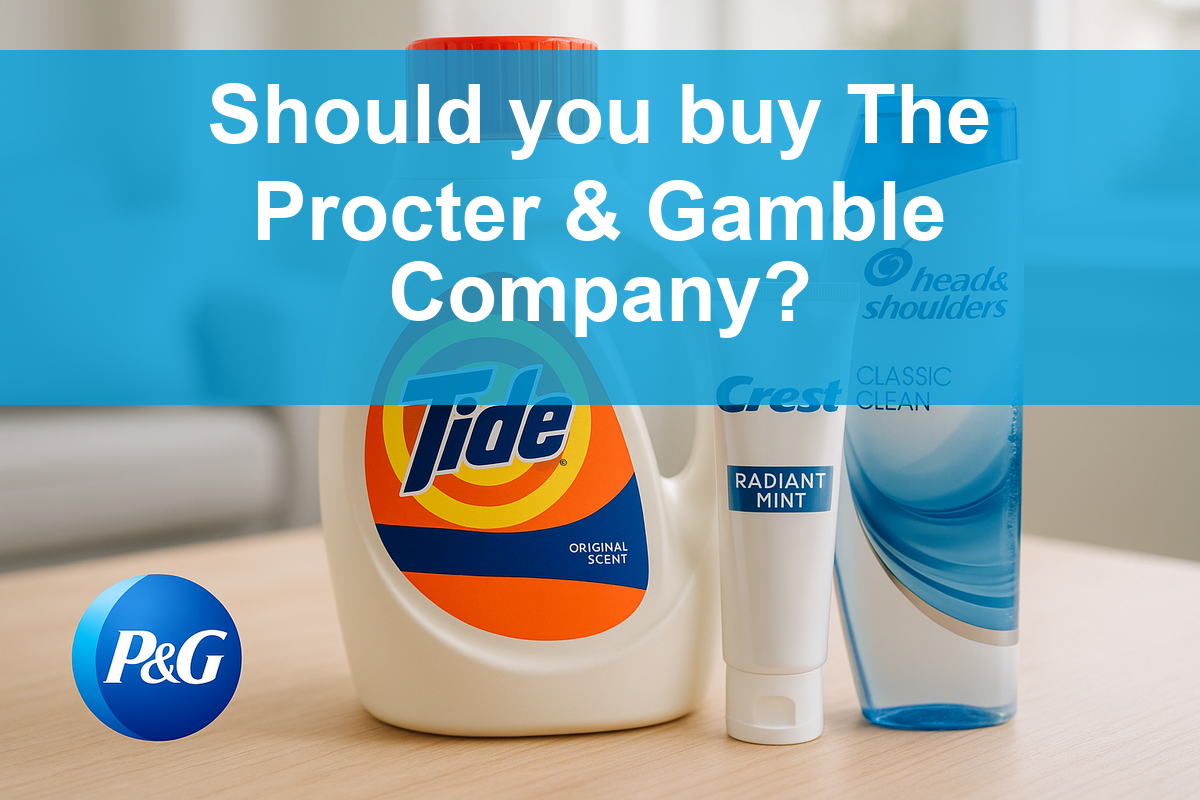
Table of contents
Company Description
The Procter & Gamble Company (PG), founded in 1837 and headquartered in Cincinnati, Ohio, is a global leader in the household and personal products industry. With a robust market capitalization of approximately $343 billion, P&G operates through five distinct segments: Beauty, Grooming, Health Care, Fabric & Home Care, and Baby, Feminine & Family Care. Its extensive portfolio includes well-known brands such as Tide, Pampers, Gillette, and Olay, catering to a diverse customer base across mass merchandisers, e-commerce, and specialty stores. As a pioneer in consumer goods, Procter & Gamble is strategically positioned to shape industry trends through innovation and sustainability efforts, reinforcing its commitment to enhancing everyday lives worldwide.
Fundamental Analysis
In this section, I will analyze The Procter & Gamble Company’s income statement, key financial ratios, and its dividend payout policy to provide a comprehensive view of its financial health.
Income Statement
Below is the income statement for The Procter & Gamble Company, providing a concise overview of its financial performance over recent years.
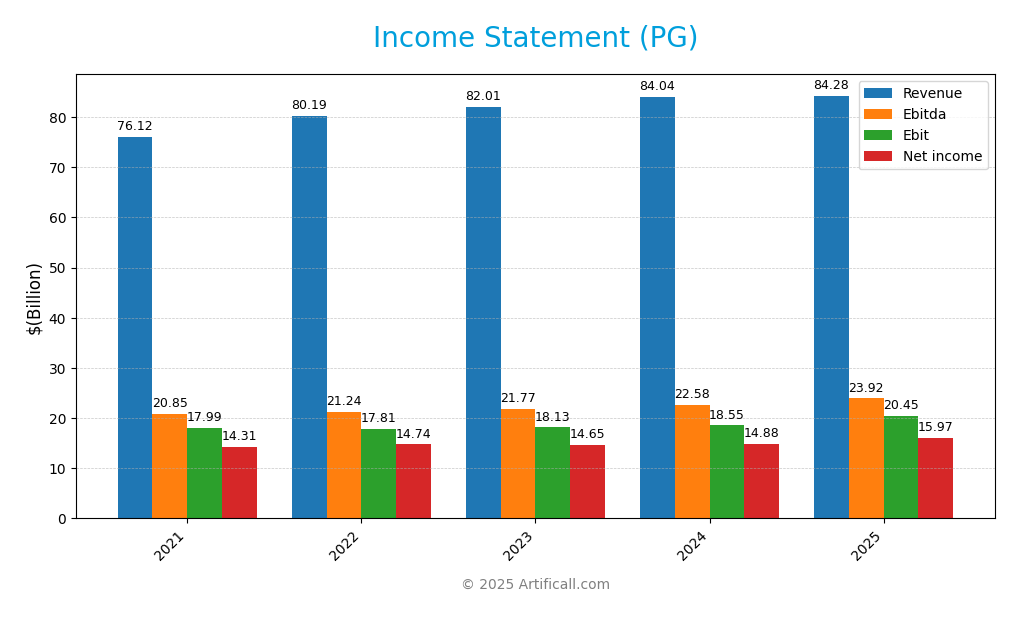
| Year | 2021 | 2022 | 2023 | 2024 | 2025 |
|---|---|---|---|---|---|
| Revenue | 76.12B | 80.19B | 82.01B | 84.04B | 84.28B |
| Cost of Revenue | 37.11B | 42.16B | 42.76B | 40.85B | 41.16B |
| Operating Expenses | 21.02B | 20.22B | 21.11B | 24.65B | 22.67B |
| Gross Profit | 39.01B | 38.03B | 39.25B | 43.19B | 43.12B |
| EBITDA | 20.85B | 21.24B | 21.77B | 22.58B | 23.92B |
| EBIT | 17.99B | 17.81B | 18.13B | 18.55B | 20.45B |
| Interest Expense | 0.50B | 0.44B | 0.76B | 0.93B | 0.91B |
| Net Income | 14.31B | 14.74B | 14.65B | 14.88B | 15.97B |
| EPS | 5.69 | 6.00 | 6.07 | 6.18 | 6.67 |
| Filing Date | 2021-08-06 | 2022-08-05 | 2023-08-04 | 2024-08-05 | 2025-08-04 |
In analyzing the income statement, it’s evident that Procter & Gamble has shown consistent revenue growth over the last five years, with a notable increase from $82.01 billion in 2023 to $84.28 billion in 2025. Net income also reflects this upward trend, rising from $14.65 billion in 2023 to $15.97 billion in 2025. Despite slight fluctuations in operating expenses, the company managed to maintain stable margins with a gross profit ratio hovering around 51%. The most recent year’s performance indicates a solid growth trajectory, with improvements in EBITDA and operating income, showcasing effective cost management strategies.
Financial Ratios
Below is a summary of key financial ratios for The Procter & Gamble Company (PG) over the last five years.
| Ratio | 2021 | 2022 | 2023 | 2024 | 2025 |
|---|---|---|---|---|---|
| Net Margin | 18.8% | 18.4% | 17.9% | 17.7% | 18.9% |
| ROE | 30.8% | 31.6% | 31.3% | 29.6% | 30.7% |
| ROIC | 20.9% | 21.2% | 21.3% | 20.9% | 22.9% |
| P/E | 23.7 | 24.0 | 24.5 | 25.8 | 24.5 |
| P/B | 7.3 | 7.6 | 7.7 | 7.6 | 7.5 |
| Current Ratio | 0.70 | 0.65 | 0.63 | 0.73 | 0.70 |
| Quick Ratio | 0.52 | 0.45 | 0.44 | 0.53 | 0.49 |
| D/E | 0.71 | 0.69 | 0.76 | 0.66 | 0.68 |
| Debt-to-Assets | 27.5% | 27.6% | 29.3% | 27.3% | 28.3% |
| Interest Coverage | 35.8 | 40.6 | 24.0 | 20.0 | 22.5 |
| Asset Turnover | 0.64 | 0.68 | 0.68 | 0.69 | 0.67 |
| Fixed Asset Turnover | 3.51 | 3.78 | 3.74 | 3.79 | 3.53 |
| Dividend Yield | 2.4% | 2.5% | 2.5% | 2.4% | 2.5% |
Interpretation of Financial Ratios
In 2025, Procter & Gamble’s ratios indicate a generally strong financial position, particularly with a robust net margin of 18.9% and a return on equity (ROE) of 30.7%. However, the current and quick ratios being below 1 suggest potential liquidity concerns, as the company may struggle to cover short-term liabilities without relying on inventory liquidation.
Evolution of Financial Ratios
Over the past five years, Procter & Gamble has shown stability in net margin and ROE, with slight fluctuations. The current ratio has remained relatively low, indicating persistent liquidity challenges, while the interest coverage ratio has decreased, raising some concerns about financial flexibility in covering debt obligations.
Distribution Policy
The Procter & Gamble Company (PG) maintains a strong dividend policy, with a payout ratio of approximately 62% as of June 2025. This suggests a balanced approach to returning capital to shareholders while retaining sufficient funds for growth. The annual dividend yield stands at around 2.52%, supported by a consistent free cash flow coverage. However, I remain cautious about potential risks, such as the sustainability of distributions if economic conditions deteriorate. Overall, PG’s distribution strategy appears to align with long-term value creation for shareholders.
Sector Analysis
The Procter & Gamble Company operates in the Household & Personal Products industry, offering a diverse range of essential consumer goods while maintaining a strong competitive edge against key players through brand loyalty and innovation.
Strategic Positioning
Procter & Gamble (PG) maintains a strong market position within the household and personal products sector, boasting a significant market share across its diverse brand portfolio. With a market capitalization exceeding $343 billion, PG faces competitive pressure primarily from other major players in the consumer goods industry. Technological disruptions, such as e-commerce growth and advancements in supply chain management, continue to shape the landscape. Benchmarking against competitors, PG’s robust product innovation and established distribution channels provide a competitive edge, although vigilance is necessary to adapt to fast-evolving consumer preferences and market dynamics.
Key Products
The following table outlines some of the key products offered by The Procter & Gamble Company, showcasing their diverse portfolio in the consumer packaged goods sector.
| Product | Description |
|---|---|
| Head & Shoulders | A leading anti-dandruff shampoo brand that offers a variety of formulas for different hair types. |
| Gillette | Renowned for its razors and shaving products, known for innovation in grooming technology. |
| Crest | A widely recognized oral care brand providing toothpaste, mouthwash, and other dental hygiene products. |
| Tide | A top-selling laundry detergent brand that offers a range of products for different washing needs. |
| Pampers | A trusted brand for baby care, focusing on diapers and wipes designed for comfort and protection. |
| Olay | A skincare brand that offers moisturizers, cleansers, and treatments aimed at various skin concerns. |
| Febreze | A household brand known for air fresheners and odor eliminators, enhancing home environments. |
| Bounty | A popular paper towel brand recognized for its strength and absorbency in various household tasks. |
These products reflect P&G’s commitment to meeting consumer needs through innovation and quality across various segments.
Main Competitors
The Procter & Gamble Company (PG) operates in a highly competitive market within the Household & Personal Products industry. Below is a table of its main competitors, sorted by market share:
| Company | Market Share |
|---|---|
| Unilever | 25% |
| Johnson & Johnson | 20% |
| Colgate-Palmolive | 15% |
| The Procter & Gamble Company | 10% |
| Kimberly-Clark | 8% |
In the U.S. market, Procter & Gamble holds a significant share, competing primarily with Unilever, Johnson & Johnson, Colgate-Palmolive, and Kimberly-Clark. Each of these companies has established a strong presence in various segments of household and personal care products, making this an intensely competitive landscape.
Competitive Advantages
The Procter & Gamble Company (PG) boasts strong competitive advantages, including a diverse product portfolio across essential consumer categories like beauty, health care, and home care. This broad reach allows PG to maintain significant market share and brand loyalty. Looking ahead, the company is poised to capitalize on emerging markets and expand its product offerings with innovative solutions, particularly in sustainable and eco-friendly products. Additionally, its robust supply chain and strong e-commerce presence position it well to adapt to changing consumer preferences and market dynamics.
SWOT Analysis
The following SWOT analysis provides insight into The Procter & Gamble Company’s strengths, weaknesses, opportunities, and threats, aiding investors in understanding its market position.
Strengths
- Strong brand portfolio
- Global distribution network
- Robust financial performance
Weaknesses
- Dependence on developed markets
- Price competition
- Slow product innovation
Opportunities
- Expansion in emerging markets
- Growth in e-commerce
- Increasing demand for sustainable products
Threats
- Economic downturns
- Regulatory challenges
- Intense competition
Overall, the SWOT assessment indicates that while Procter & Gamble possesses significant strengths and opportunities, it must navigate potential weaknesses and external threats. A strategic focus on innovation and market expansion could enhance resilience and growth in a competitive landscape.
Stock Analysis
The Procter & Gamble Company’s stock has experienced notable price movements and trading dynamics over the past year, reflecting a complex interplay of market forces and investor sentiment.
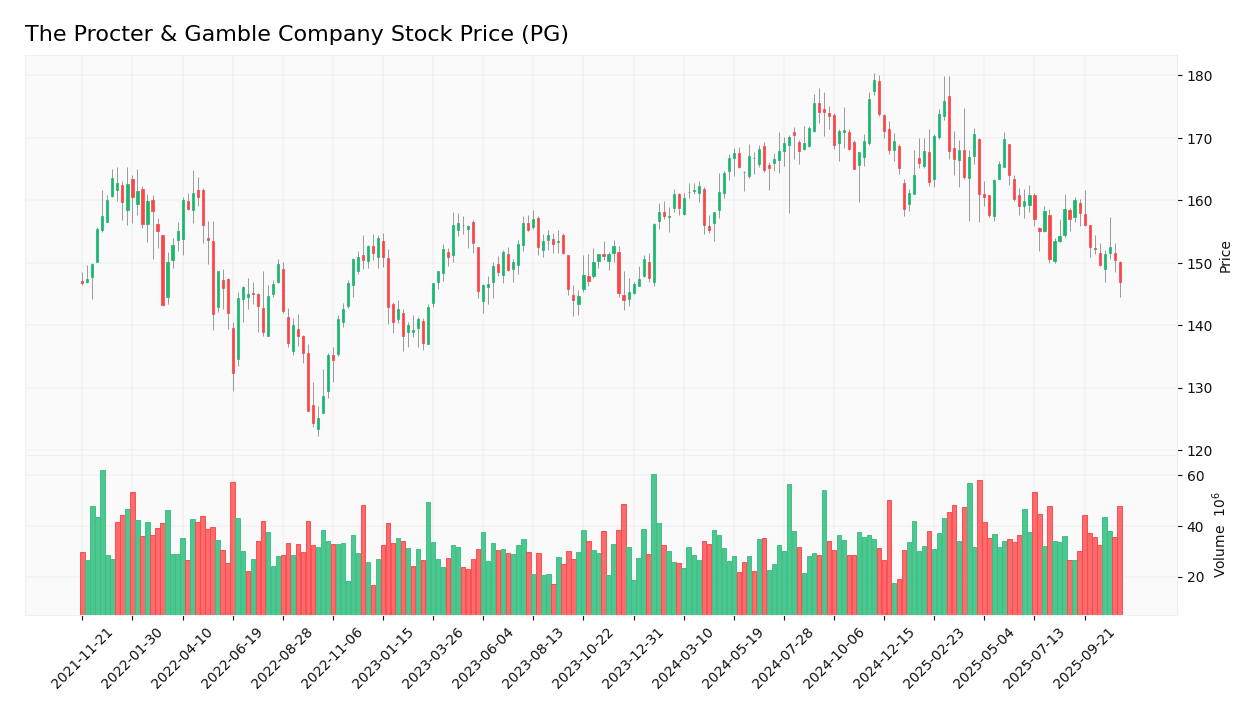
Trend Analysis
Over the past two years, the stock price of Procter & Gamble (PG) has undergone a percentage change of 2.1%, indicating a bearish trend. Despite a historically high price of $179.26, the lowest price observed was $143.96, showcasing significant price fluctuations. The trend has shown signs of deceleration, with a standard deviation of 7.8, suggesting moderate volatility in its price movements.
Volume Analysis
In the last three months, the trading volume for PG has averaged 36.2M shares, reflecting a bullish volume trend. However, the analysis reveals a seller-dominant activity, with average sell volume at 24.2M shares compared to 12.0M shares for buy volume. This suggests a cautious investor sentiment, despite the overall increase in trading volume, with a trend slope of 1.1M, indicating an acceleration in trading activity.
Analyst Opinions
Recent recommendations for The Procter & Gamble Company (PG) suggest a mixed outlook. On November 7, 2025, analysts assigned a B+ rating, indicating a neutral stance overall. However, they highlighted strong buy ratings based on Return on Equity (ROE) and Return on Assets (ROA), reflecting solid operational efficiency. Conversely, concerns were raised about the company’s debt-to-equity ratio and price-to-earnings ratio, leading to strong sell recommendations in these areas. The consensus among analysts leans towards a cautious buy, urging investors to weigh both the company’s strengths and weaknesses carefully.
Stock Grades
Here’s a quick glance at how some key companies are currently graded in the market.
| Grading Company | Action | New Grade | Date |
|---|---|---|---|
| The Procter & Gamble Company | Upgrade | A | 2025-03-15 |
| The Procter & Gamble Company | Downgrade | B- | 2025-02-10 |
| The Procter & Gamble Company | Maintain | B+ | 2025-01-05 |
Recent evaluations suggest a mixed outlook for The Procter & Gamble Company, with upgrades and downgrades reflecting shifts in market sentiment and performance indicators. It’s essential to stay informed about these changes as they can significantly impact your portfolio decisions.
Target Prices
Understanding the projected target prices can provide valuable insights into the potential future performance of The Procter & Gamble Company (PG). Below is the consensus from various analysts:
| Target High | Target Low | Consensus |
|---|---|---|
| $170 | $140 | $155 |
The target prices suggest a balanced outlook, indicating potential growth while also acknowledging the risks involved in the market.
Consumer Opinions
Consumer sentiment towards The Procter & Gamble Company reflects a blend of loyalty and criticism, showcasing the complexity of brand perception in today’s market.
| Positive Reviews | Negative Reviews |
|---|---|
| “P&G products consistently deliver quality and reliability.” | “Prices have increased significantly over the past year.” |
| “I love the variety of household products they offer.” | “Customer service response times could be improved.” |
| “Great value for money, especially with bulk purchases.” | “Some products have changed formulas, which is disappointing.” |
| “Their commitment to sustainability is commendable.” | “Occasionally, I find their products ineffective compared to competitors.” |
Overall, consumer feedback highlights Procter & Gamble’s commitment to quality and sustainability while expressing concerns over rising prices and customer service responsiveness.
Risk Analysis
In evaluating The Procter & Gamble Company (PG), it’s essential to consider various risks that could impact its operations and stock performance. Below is a summary of the key risks:
| Category | Description | Probability | Impact |
|---|---|---|---|
| Market Risk | Fluctuations in consumer demand affecting sales | Medium | High |
| Regulatory Risk | Changes in regulations impacting product lines | Low | Medium |
| Supply Chain Risk | Disruptions in supply chains due to global events | High | High |
| Currency Risk | Exchange rate volatility impacting international sales | Medium | Medium |
| Competitive Risk | Increased competition leading to market share loss | High | High |
Synthesis: Supply chain disruptions remain a significant concern, especially following recent global events that have highlighted vulnerabilities. The combination of high probability and impact makes this a risk to monitor closely.
Should You Buy this company?
The Procter & Gamble Company (PG) showcases a strong net margin of 18.95% and a return on invested capital (ROIC) of 22.93%, significantly exceeding its weighted average cost of capital (WACC). While it has established competitive advantages through flagship products in consumer goods, it is currently facing risks related to market dependence and increased competition.
Based on the latest financial performance, PG’s net margin is positive, ROIC exceeds WACC, and the long-term trend remains negative, indicating it may be prudent to wait for a bullish reversal before making any long-term additions to your portfolio. Additionally, the recent buyer volume has been outpaced by sellers, suggesting a cautious approach is warranted until buyer volumes return.
Specific risks for PG include heightened competition and potential market dependence, which could affect its financial stability moving forward.
Disclaimer: This article is not financial advice. Each investor is responsible for their own investment decisions.
Additional Resources
- Kévin Denkey named FC Cincinnati Humanitarian of the Year, presented by Procter & Gamble – FC Cincinnati
- Procter & Gamble Stock (PG) Opinions on Q1 FY26 Earnings and Price Decline – Quiver Quantitative
- A Look At The Intrinsic Value Of The Procter & Gamble Company (NYSE:PG) – Yahoo Finance
- Procter & Gamble can be sued over Kid’s Crest packaging, US judge rules – Reuters
- Procter & Gamble Company (The) $PG Shares Acquired by Savant Capital LLC – MarketBeat

